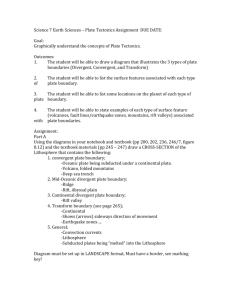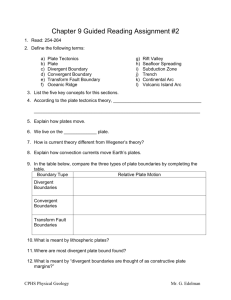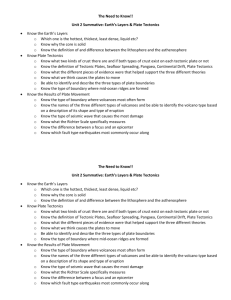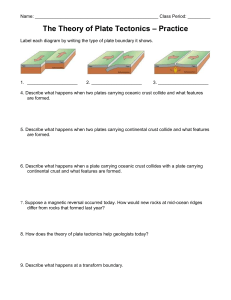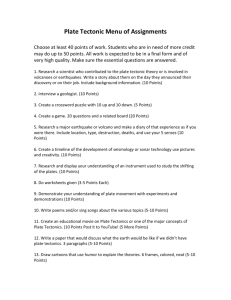GEO144_lab_2 - earthjay science
advertisement
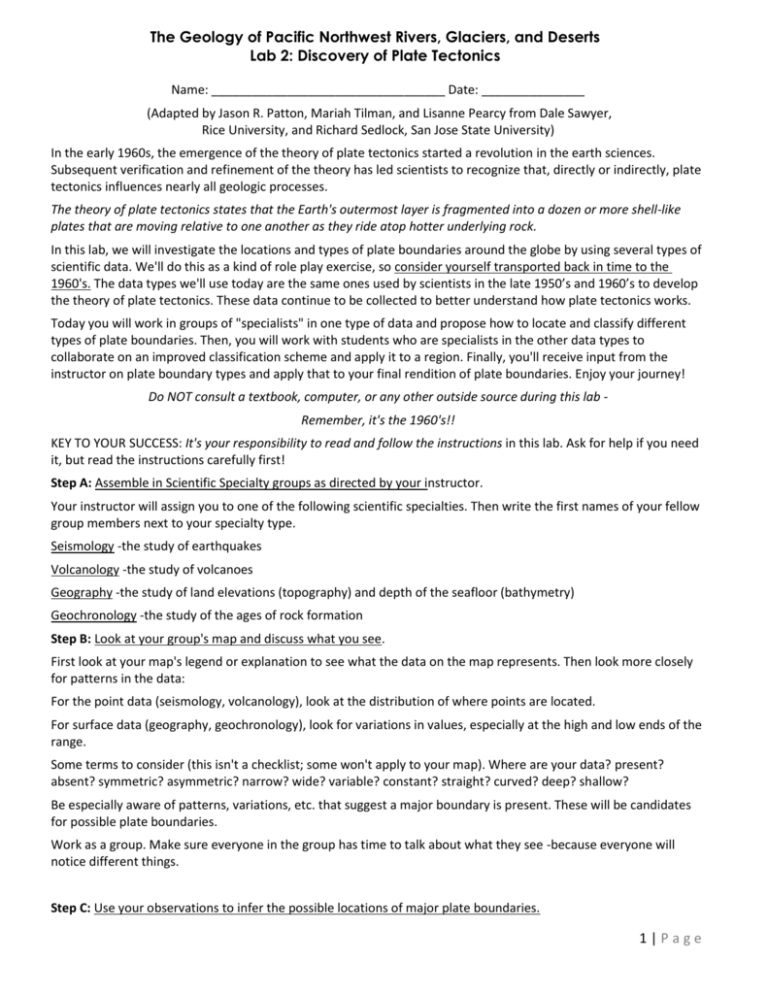
The Geology of Pacific Northwest Rivers, Glaciers, and Deserts Lab 2: Discovery of Plate Tectonics Name: __________________________________ Date: _______________ (Adapted by Jason R. Patton, Mariah Tilman, and Lisanne Pearcy from Dale Sawyer, Rice University, and Richard Sedlock, San Jose State University) In the early 1960s, the emergence of the theory of plate tectonics started a revolution in the earth sciences. Subsequent verification and refinement of the theory has led scientists to recognize that, directly or indirectly, plate tectonics influences nearly all geologic processes. The theory of plate tectonics states that the Earth's outermost layer is fragmented into a dozen or more shell-like plates that are moving relative to one another as they ride atop hotter underlying rock. In this lab, we will investigate the locations and types of plate boundaries around the globe by using several types of scientific data. We'll do this as a kind of role play exercise, so consider yourself transported back in time to the 1960's. The data types we'll use today are the same ones used by scientists in the late 1950’s and 1960’s to develop the theory of plate tectonics. These data continue to be collected to better understand how plate tectonics works. Today you will work in groups of "specialists" in one type of data and propose how to locate and classify different types of plate boundaries. Then, you will work with students who are specialists in the other data types to collaborate on an improved classification scheme and apply it to a region. Finally, you'll receive input from the instructor on plate boundary types and apply that to your final rendition of plate boundaries. Enjoy your journey! Do NOT consult a textbook, computer, or any other outside source during this lab Remember, it's the 1960's!! KEY TO YOUR SUCCESS: It's your responsibility to read and follow the instructions in this lab. Ask for help if you need it, but read the instructions carefully first! Step A: Assemble in Scientific Specialty groups as directed by your instructor. Your instructor will assign you to one of the following scientific specialties. Then write the first names of your fellow group members next to your specialty type. Seismology -the study of earthquakes Volcanology -the study of volcanoes Geography -the study of land elevations (topography) and depth of the seafloor (bathymetry) Geochronology -the study of the ages of rock formation Step B: Look at your group's map and discuss what you see. First look at your map's legend or explanation to see what the data on the map represents. Then look more closely for patterns in the data: For the point data (seismology, volcanology), look at the distribution of where points are located. For surface data (geography, geochronology), look for variations in values, especially at the high and low ends of the range. Some terms to consider (this isn't a checklist; some won't apply to your map). Where are your data? present? absent? symmetric? asymmetric? narrow? wide? variable? constant? straight? curved? deep? shallow? Be especially aware of patterns, variations, etc. that suggest a major boundary is present. These will be candidates for possible plate boundaries. Work as a group. Make sure everyone in the group has time to talk about what they see -because everyone will notice different things. Step C: Use your observations to infer the possible locations of major plate boundaries. 1|Page The Geology of Pacific Northwest Volcanoes, Mountains and Earthquakes Activity 1: Discovery of Plate Tectonics C-1. Come to an agreement in your group on at least four regions around the world that could be plate boundaries. C-2. Below, list and describe the specific criteria or features of your map data you used to infer the locations of plate boundaries. C-3. Draw these four regions on your group blank “Discovery of Plate Tectonics Coastline Map.” 2|Page The Geology of Pacific Northwest Rivers, Glaciers, and Deserts Lab 2: Discovery of Plate Tectonics Step D: Classify known plate boundaries into different types based on your specialty data. D-1. Write your name, your Specialty Group name and "Step D" on your own map. This Plate Boundary Map shows some widely accepted locations for major plate boundaries around the world. There are bound to be some differences from what you inferred in Step C, because you had only one type of data to look at, while the scientists who made the plate boundary map had other sources. That's OK. Your task now is to categorize the boundaries on the Plate Boundary Map into different "types" that share similar characteristics as expressed in your data set. Each scientific specialty should be able to propose at least two plate boundary types, and some groups should be able to propose up to 4-5 types. Try not to apply what you knew before coming to class. DO NOT give names to the boundary types; just use your observations of the data on your map as the basis for this classification attempt. (You may want to refer back to the terms suggested in Step B to get you started.) List the major characteristics of each boundary type your group recognizes below (minimum 2 types, maximum 4 types). Remember: You are not trying to explain why the data show the features they do -- just describe how to recognize each boundary type! Your key below should be clear enough that anyone could read it and then find examples of each boundary type on your group's data map. Type 1 Type 2 Type 3 Type 4 D-2. On your Plate Boundary Map and in your key above, mark your proposed boundary types using a different colored pencil for each type. Note: Some boundary types may be asymmetrical (different on one side than the other); if so, devise a way to show this on the map, and explain it in your key above. You won't be graded on whether your categories are "right" or not, only on whether they are reasonable and your descriptions are complete based on the data in your specialty. 3|Page The Geology of Pacific Northwest Volcanoes, Mountains and Earthquakes Activity 1: Discovery of Plate Tectonics Step E: Give everyone in your group a number. Write your number here: Step F: Get together with everyone else in the class who has the same number as you from Step E. Every group should have 4 people, one from each Specialty Group. Write the names of your group members here: Step G: Share your observations and interpretations. You are now the group specialist in your data type! It's your responsibility to bring the rest of your group up to speed. The instructor will show the specialty maps on the projector, one by one, so that each specialist in your new group has a chance to explain their map briefly to the others: What the data are and how they are symbolized Major patterns and variations your Specialty Group observed in the data Where major boundaries stand out on the world map The boundary types you proposed in Step D and the reasons for your classification Step H: Develop a second classification of plate boundary types, based on all four Scientific Specialties. Your instructor will assign your group a region of the Earth to work on. Write the name of your region here: H-1. Write your name on your regional “Discovery of Plate Tectonics Coastline” map. Compare the types of plate boundaries that each of you inferred from your particular specialty. Your interpretations probably differ (which is fine). H-2. Reconcile the differences and propose a consensus group scheme of boundary types that works for your assigned region. Be sure to include all the boundaries of your assigned plate(s) in your scheme. Describe them below. Mark each type with a different colored pencil below and on your new Plate Boundary Map. Describe any boundary asymmetries clearly and show them on your map. Type A Type B Type C Type D Make sure your map has a legend showing the colors you used for each boundary type. That's it for Step H. Leave your boundary types and map as they are. No modifications later! You won't be graded on whether your categories are "right" or not, but on whether they are reasonable and your descriptions are complete, based on the data available for your assigned plate(s). 4|Page The Geology of Pacific Northwest Rocks & Minerals Lab 2: Discovery of Plate Tectonics Last Step I. Formally classify global plate boundaries. I-1. The last page of this lab is a fact sheet on the types of plate boundaries that geoscientists currently recognize. You will also receive yet another copy of the Plate Boundary Map for step I. Write your name and the name(s) of your assigned region on your new map. I-2. Classify the boundaries of your assigned plate(s) and any other plates that you choose to include, according to the boundary types shown on the fact sheet. Use colored pencils to distinguish the boundary types on your new Plate Boundary Map, and make sure to add a legend to your new map explaining what each color means. As before, where boundaries are asymmetrical, indicate which side is which on your map. I-3. List all the formally recognized boundary types below and specify which criteria are diagnostic of each. In other words, if you were investigating another Earth-like planet on which plate tectonics operated, which specific features/patterns/variations/etc. could help you find each boundary type? Hint: Describe criteria from all specialty data types that apply to each boundary type. Boundary Type: Map criteria: Boundary Type: Map criteria: Boundary Type: Map criteria: Boundary Type: Map criteria: 5|Page The Geology of Pacific Northwest Volcanoes, Mountains and Earthquakes Activity 1: Discovery of Plate Tectonics 6|Page




